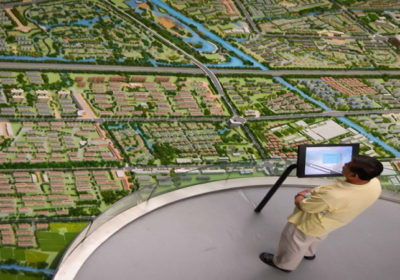
The last COP26, the international climate summit held in Glasgow, has once again highlighted the growing awareness and concern for the environment, urbanization and technological development that a large part of society possesses, and which has given rise to an urgent need, and an urgent opportunity, to rethink the way we build and manage our cities.
Perhaps this is not something new, as we are aware that, in recent decades, these interrelated issues began to converge to give shape to what is generically referred to as “Sustainable Smart Cities”, with the term “sustainable” gaining weight in the whole concept of what a Smart City represents.
If in previous publications we have perhaps placed more emphasis on the technological aspect of Smart Cities, we cannot leave aside the environmental aspects that are undoubtedly part of the “smart” concept, and which are included within the global objectives of all the countries that have signed the different COP26 agreements to continue working for a cleaner world, free of harmful emissions and with a view to a recovery of our natural ecosystem.
Globalization of environmental and sustainable development issues
COP26 is only the latest global attempt to tackle a very complex problem. A series of UN conferences over the last forty years have highlighted the increasingly global nature of the problems that exist in our natural ecosystem. Until the 1972 Stockholm conference, environmental problems were seen primarily as local issues: they were created locally and had local effects. But, in recent decades, it has become increasingly clear that this is not the case. The Brundtland Commission report of the World Conference on Environment and Development put the concept of sustainable development on the agenda, and the subsequent Rio and Cape Town conferences kept it there. Under the slogan “think global, act local,” the Agenda 21 action plan clearly pointed out the importance of local implementation and action to reduce environmental problems, and the social effects they cause at the global level.
One of the most obvious examples of this imbalance is climate change. Since 1988, the Intergovernmental Panel on Climate Change (IPCC) has studied the causes and possible effects of human action on the environment and, in subsequent reports, has refined its conclusions: climate change is mainly driven by human activities. Since cities are responsible for 80% of the greenhouse gas emissions that we release into the atmosphere, it is a problem that affects those of us who seek to transform our cities into Smart Cities and reduce the impact they have on the planet’s natural environment.
Urbanization and population growth
When the 20th century began, around 12.5% of the population, some 200 million people, lived in cities. One hundred years later, these figures have risen to 52%, some 3.6 billion people. According to these statistics, more than half of the world’s population now lives in cities, a percentage that is increasing, as we have commented on other occasions, since according to the United Nations Department of Economic and Social Affairs, “the world’s urban areas are expected to absorb all the population growth expected over the next four decades, while attracting part of the rural population”. Thus, it is estimated that by 2050 the urban population will account for 67-70% of the world’s population, albeit with large regional differences.
In the more developed parts of the world, 86% of the population is expected to be urban in 2050, while in the less developed parts of the world, the urban proportion is likely to reach “only” 64%. According to UN DESA, the UN’s department of economic and social affairs, most urbanization will occur through the growth of existing urban areas, but contrary to what one might think, most of this growth is expected to occur in relatively small cities, at least at this time.
Public and private initiatives collaborating in urban transformation processes
Thus, with more than half of the world’s population living in urban areas, the use of energy, land and other resources is increasing. The current concentration of the world’s population in cities means that cities are becoming increasingly important in addressing sustainable development issues. Sustainable urban development has thus become a prerequisite for any city improvement project. And “sustainable”, here, is no longer a buzzword or a concept that we put in the title of each project because that is what is expected of it, but a requirement without which these projects, in many cases, do not go ahead.
Combining local and international proposals, networks such as ICLEI (Local Governments for Sustainability), the climate leadership group C40 Cities and the Clinton Climate Initiative – Cities Program (CCI) among many other such networks, agencies and initiatives, aim to learn from each other and exchange experiences on how best to promote sustainable urban development in practice.
Because of this, i.e. because the public sector involved in the growth of our cities is launching initiatives to make urban areas part of the solution for the way society will live in the future, the concept is also increasingly used by private sector actors, especially consultancies and construction companies for buildings, urban districts or entire cities. In Sweden, an example of this is “SymbioCity”, a marketing platform developed and managed by Business Sweden with the explicit aim of promoting Swedish companies in the international market for green cities, an area that has tended to focus on city-based infrastructure such as sewerage, water, energy and waste management in the city.
A transformation that has been decades in the making
The origin of the Smart Cities concept dates back, at least, to the Growth Movement of the late 1990s. But we also mentioned in a previous publication that the foundations of Smart Cities are to be found in what have been called “cybernetically planned cities”, i.e. the “digital” cities of the 1960s, in which numerous proposals arose to network our cities and create city development plans taking into account ICTs as their driving force, something that grew in the 1980s and onwards.
Perhaps for this reason, Smart Cities are today an advanced concept on which the private sector is betting heavily. From a business point of view, combining new technologies for communications, data collection and management, information storage, processing and analysis, preventive management, etc., within the framework of the “smart city” has the potential to launch a kind of wholesale concept in which companies, start-ups and companies that are at the forefront in the development of solutions to deal with the problems of our cities will have a lot of room for growth and expansion in the decades to come. Moreover, most of the ICTs included in smart city conceptual models have already existed for years. What is new is increasingly the interconnection, combination and synchronization of these, as well as the development of the systems they include so that they work in concert. This is also where the challenge lies and what makes the market so interesting for small and large companies that have the potential to develop such complex solutions within the scope of the new Industry 4.0.
Global impacts of “local” urban actions
As mentioned above, initiatives to create “sustainable smart cities” have typically focused on technical solutions to achieve a more efficient urban metabolism, and the sustainability of a city has focused on reducing the impact occurring within its administrative and geographical boundaries.
The main reason is that few (if any) cities are self-sufficient. To maintain the quality of life of its citizens, the city depends on a territory from which resources are extracted and to which the pollutants and waste produced by the city are irremediably returned.
Due to the processes of industrialization, urbanization and globalization, an increasing part of the goods consumed in a city is produced further and further away from the city. This means that the environmental impacts of the consumption that takes place by all the inhabitants, industries and services of the city are dispersed throughout the world and, consequently, that the environmental impact of a city cannot be limited to the “urban metabolism” within the city limits. Therefore, a better understanding of the concept of “sustainable cities” requires a global perspective in which sustainability assessments and urban developments are made taking into account the global consequences of local action or inaction.
Thus, a broad perspective of the environmental impact that a Smart City has can essentially be obtained in two different ways. One is to use an approach based on the analysis of the environmental impact of the production of the resources that the city needs, assessing the full life cycle of these, which means that the impact of a city is determined by including all processes upstream and downstream of the production chain and the supply chain wherever these have been produced.
The second way is to use a consumption-based approach, which leads us to determine the environmental impact of a city based on the consumption and use of resources by its inhabitants, regardless of where the production of the consumed goods takes place. Whichever approach we use, a calculation of the ecological impact of a Smart City needs to take into account what the city needs to function properly, in what measure and quantity, how much of it is used or wasted, what impact the consumption of all that is required to sustain a certain standard of living has had, and what costs its production, transfer, supply and other processes that have been part of the life cycle of the city’s resources have had.
Strategic evaluation of the resources required by the city
In order to carry out this type of analysis, it is necessary to start from the obvious: every city depends on the import of goods to supply what it cannot produce and the export of what it has left over and does not consume. A “sustainable” city is one that can minimize the environmental impact generated in the process of importing resources plus that which appears in the process of exporting surpluses.
If the city’s needs can be assessed, and the resources that have the least environmental impact can be sought to cover them (in terms of energy production, food supply, raw materials, water, services, transportation, etc.), as well as finding ways to minimize this same impact in what we export outside the limits of our Smart City, the sustainability of the production, supply and consumption chain and of the city’s management processes can be considered to be on the rise.
Mitigation measures
For those aspects where the environmental impact cannot be eliminated by making changes in the production, supply and consumption processes of the city’s resources, we have to look for mitigation measures.
Historically, infrastructure development and investment in industrial improvements have led to substantial improvements in the welfare and wealth of every city on the planet. We have millions of examples where, thanks to the implementation of improved transportation, energy, recycling, wastewater management, etc., the lives of billions of people have been improved.
As part of this, urban infrastructure has made it possible to create and develop more efficient systems for commerce and business of all kinds that are everywhere in every city, and this makes the development of efficient infrastructure in many ways the backbone of the modern city and the solution to maintaining a growing standard of living for society as a whole. However, on the other hand, it is also true that the very infrastructures of our cities have allowed us to ruin ecosystems and exploit natural resources to an extent that threatens the very existence of this modern society. We have used industrial and technological development to advance humanity and to improve life in our cities, but we have not curbed or limited the impact this has had on nature.
In this sense, the mitigation measures that ICT allows us to design and implement are extremely important and, today, play an increasingly vital role in the maintenance and development of society, as they have the potential to support a sustainable and resource-efficient way of life. An example of this is the use of ICT to manage traffic flow in cities, to measure and regulate household electricity or water consumption, to encourage waste recycling, to monitor energy expenditure in industrial areas, to optimize and make better use of raw materials, etc.
Top-Down and Bottom-Up approaches
The implementation of these technological solutions can also take place through two different approaches. Macro and global solutions can be approached in a broad way, being commissioned to companies that, starting from more or less generic products or systems, adapt them to the particular circumstances of our city, or they can be implemented starting by implementing technological solutions on a very small scale in a small area of the city and scaling up to the whole, making the necessary adjustments as the results of the process are seen.
The first approach has the advantage that we start with a standard technological solution that has possibly already been tested in other cities, whether it is a traffic control software or a photovoltaic installation that always has the same basic components and requires only a few calculations to be replicated in another part of the planet. The second way to implement technologies that ensure the sustainability of the city is to focus on a specific problem and develop a local solution for it, make it work and then scale the process to be implemented throughout the Smart City.
In general, the optimal solution usually involves combining both ways to reduce the environmental impact of the city by improving its internal processes, and it is a matter of the singularities and problems that each city has with its supply, production, supply and consumption systems that one or the other is used to a greater or lesser extent.
Smart cities must be sustainable by definition
In any case, nothing can be done in a city without an associated study of its environmental impact and how it can contribute to the sustainability of all the mechanisms present in the city with respect to its relationship with the natural ecosystem where it is located. Everyone is now aware that the rate of abuse of nature is getting out of our control and, therefore, no city can hide its head when it comes to incorporating as many mechanisms as possible in its processes of change towards intelligent management systems without taking into account what impact these changes may have. Any technological implementation must clearly show whether it will bring a reduction in the city’s carbon footprint, in its air quality, in the optimal use of its resources, in the improvement of its waste recycling systems, in the reduction of the use of raw materials and non-renewable energies and, in short, in the set of processes that make the Smart City can help to recover the ecosystem of the territory where it is located, or, at least, not damage it and remain neutral with respect to the impact on it.
The management and municipal teams of our cities are learning, in many cities around the world, that both concepts (technological development and respect for the environment) go hand in hand if the city is to grow and maintain the level of services that will allow all its residents to enjoy a growing standard of living, not only for those who live there now, but also for the enormous demographic increase that all the cities of the planet are expected to have in the coming years.



